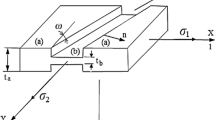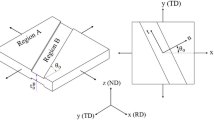Abstract
This study uses the Marciniak and Kuczynski (M-K) method to present an analytical forming limit diagram (FLD) for sheet metals. The procedure for the analytical FLD prediction is described in detail and step-wise manner, and an algorithm is written using MATLAB. First, an appropriate algorithm is determined to establish the theoretical analyses, and various anisotropic yield functions, such as Hill’s 48, Barlat 89, and Hosford, are considered. The predicted FLDs are compared with experiments involving a typical AA6016-T4 aluminum alloy. Second, the Gurson model that considers damage growth is implemented when Hosford is the yield function, as Hosford criterion predicts the best comparable analytical FLD with experiments among the yield functions. Third, a parametric study is performed to investigate the effects of parameters on the FLD prediction. Results indicate that an extremely low value for the initial void volume fraction in the safe and groove zones has minimal effects on the FLD prediction. Lastly, the values of void volume fractions are calculated assuming no geometrical imperfections and the imperfection is because of higher void volume fraction in groove zone than that in safe zone.











Similar content being viewed by others
References
Butuc MC, da Roch B, Gracio JJ, Ferreira Duarte J (2002) A more general model for forming limit diagrams prediction. J Mater Process Technol 125:213–218
Butuc M, Gracio J, Da Rocha AB (2003) A theoretical study on forming limit diagrams prediction. J Mater Process Technol 142(3):714–724
Hill R (1948) A theory of the yielding and plastic flow of anisotropic metals. Proc R Soc Lond A 193(1033):281–297
Hill R. Theoretical plasticity of textured aggregates. In mathematical proceedings of the Cambridge philosophical society. 1979. Cambridge University Press
Barlat F, Maeda Y, Chung K, Yanagawa M, Brem JC, Hayashida Y, Lege DJ, Matsui K, Murtha SJ, Hattori S, Becker RC, Makosey S (1997) Yield function development for aluminum alloy sheets. Journal of the Mechanics and Physics of Solids 45(11–12):1727–1763
Ganjiani M, Assempour A (2007) An improved analytical approach for determination of forming limit diagrams considering the effects of yield functions. J Mater Process Technol 182(1–3):598–607
Hosford WF (1979) On yield loci of anisotropic cubic metals. in Proceedings of the Seventh North American Metal working Conference SME
Gologanu M, Leblond JB, Devaux J (1993) Approximate models for ductile metals containing non-spherical voids—case of axisymmetric prolate ellipsoidal cavities. Journal of the Mechanics and Physics of Solids 41(11):1723–1754
Lievers W, Pilkey A, Lloyd D (2003) The influence of iron content on the bendability of AA6111 sheet. Mater Sci Eng A 361(1):312–320
Lievers W, Pilkey A, Lloyd D (2004) Using incremental forming to calibrate a void nucleation model for automotive aluminum sheet alloys. Acta Mater 52(10):3001–3007
Chen ZT, Worswick MJ, Cinotti N, Pilkey AK, Lloyd D (2003) A linked FEM-damage percolation model of aluminum alloy sheet forming. Int J Plast 19(12):2099–2120
Gurson AL (1977) Continuum theory of ductile rupture by void nucleation and growth: part I—yield criteria and flow rules for porous ductile media. J Eng Mater Technol 99(1):2–15
Tvergaard V, Needleman A (1984) Analysis of the cup-cone fracture in a round tensile bar. Acta Metall 32(1):157–169
Needleman A, Triantafyllidis N (Apr 1978) Void growth and local necking in biaxially stretched sheets. J Eng Mater Technol 100(2):164–169
Chelovian M, Kami A (2020) Study on formability of AISI 304 steel sheet using MK model and GTN damage criterion. Journal of Mechanical Engineering 50(1):71–79
Ragab A and Bayoumi SEA, Engineering solid mechanics: fundamentals and applications. 1998: CRC Press
Kim Y, Won S, Kim D, Son H (2001) Approximate yield criterion for voided anisotropic ductile materials. KSME international journal 15(10):1349–1355
Kim YS, Won SY, Na KH (2003) Effect of material damage on forming limits of voided anisotropic sheet metals. Metall Mater Trans A 34(6):1283–1290
Kim YS, Son HS and Lee SR, Prediction of forming limits for voided anisotropic sheets using strain gradient dependent yield criterion. In key engineering materials. 2003. Trans Tech Publ
Hosseinia ME, Hosseinipour SJ, Bakhshi-Jooybari M (2017) Theoretical FLD prediction ased on M-K model using Gurson's plastic potential function for steel sheets. Procedia Engineering 183:119–124
Son HS, Kim YS (2003) Prediction of forming limits for anisotropic sheets containing prolate ellipsoidal voids. Int J Mech Sci 45(10):1625–1643
Barlat F, Lian K (1989) Plastic behavior and stretchability of sheet metals Part I: A yield function for orthotropic sheets under plane stress conditions. International journal of plasticity 5(1):51–66
Geng L, Wagoner R (2002) Role of plastic anisotropy and its evolution on springback. Int J Mech Sci 44(1):123–148
Ganjiani M, Assempour A (2008) Implementation of a robust algorithm for prediction of forming limit diagrams. J Mater Eng Perform 17(1):1–6
Chu C, Needleman A (1980) Void nucleation effects in biaxially stretched sheets. Journal of Engineering Material and Technology 102(3):249–256
Tvergaard V (1982) On localization in ductile materials containing spherical voids. Int J Fract 18(4):237–252
Wu PD, Neale KW, Van Der Giessen E, Jain M, MacEwen SR, Makinde A (1998) Crystal plasticity forming limit diagram analysis of rolled aluminum sheets. Metall Mater Trans A 29(2):527–535
Ragab A, Saleh C, Zaafarani N (2002) Forming limit diagrams for kinematically hardened voided sheet metals. J Mater Process Technol 128(1–3):302–312
Shahzamanian MM (2018) Anisotropic gurson-tvergaard-needleman plasticity and DamageModel for finite element analysis of elastic-plastic problems. International Journal of Numerical Methods in Engineering 115(13):1527–1551
Zaman TN (2008) Effects of strain path changes on damage evolution and sheet metal formability. MSc thesis, McMaster University
Author information
Authors and Affiliations
Corresponding author
Ethics declarations
Conflict of interest
The authors declare that they have no conflict of interest.
Additional information
Publisher’s note
Springer Nature remains neutral with regard to jurisdictional claims in published maps and institutional affiliations.
Rights and permissions
About this article
Cite this article
Shahzamanian, M.M., Wu, P.D. Study of forming limit diagram (FLD) prediction of anisotropic sheet metals using Gurson model in M-K method. Int J Mater Form 14, 1031–1041 (2021). https://doi.org/10.1007/s12289-021-01619-7
Received:
Accepted:
Published:
Issue Date:
DOI: https://doi.org/10.1007/s12289-021-01619-7




